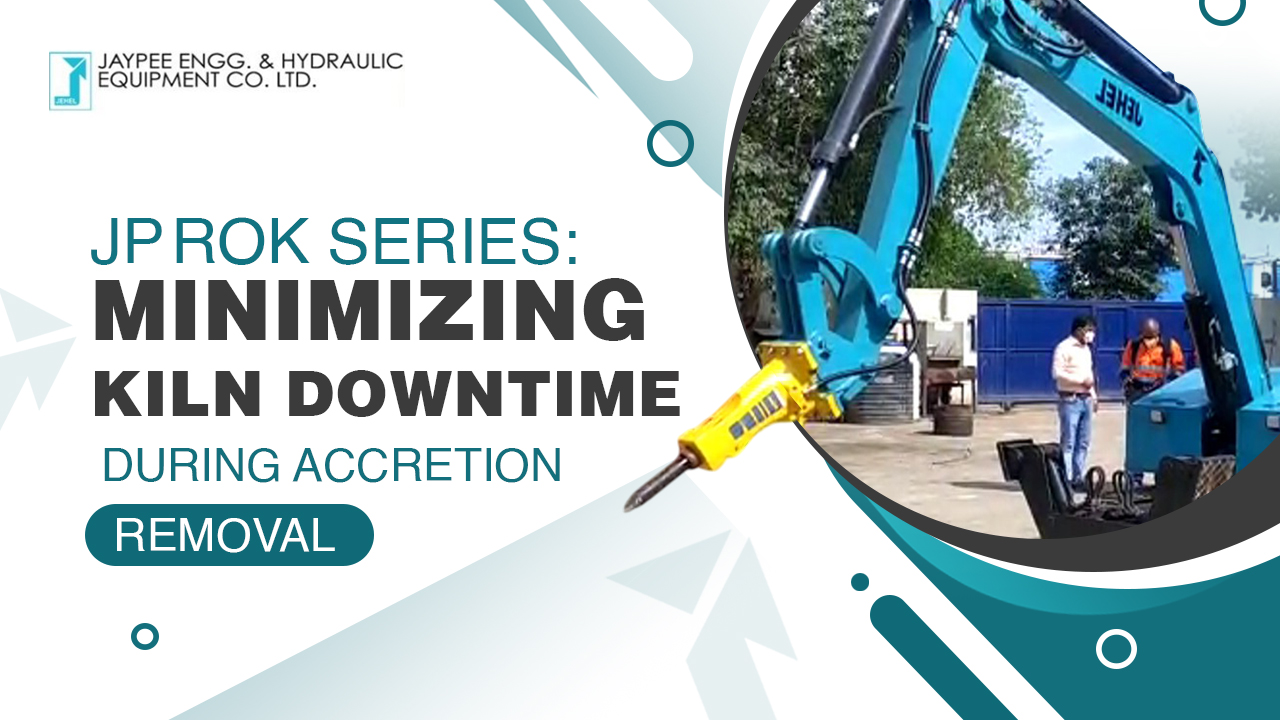Every minute of kiln stoppage costs cement businesses thousands of dollars. In the cement industry, maintenance costs can make up anywhere from 15% to 40% of total production costs. With the cement kilns market expected to reach USD 2.21 billion by 2030, growing at a CAGR of 4.6%, the need to maximize uptime has never been this critical. Plant managers all over the world face the relentless problem of accretion removal—that stubborn material buildup that can take days to remove.
In the JP ROK series of machines, we find an answer to the problem of operational efficiency in cement plants. These machines are more advanced than traditional maintenance in cement processing plants since they ensure a transition from a hands-on maintenance approach to a more automated and streamlined time-saving approach.
Compared to a traditional concrete demolition machine used in larger construction zones, they are frequently thought to be more portable and versatile.
Understanding the Accretion Challenge
Every process has its challenges. With this in mind, accretion formation is one of the more challenging facets of cement kiln operations. These hard, cement-like accumulations are significantly annoying, and the accumulations tend to become thicker and greater slowly. In addition to the bulging formation of kiln cement, these accretions greatly slow down the operation of the kiln. This, in turn, directly impacts the expensive maintenance shutdowns.
The construction process is gradual. Each time an element is heated inside a kiln, certain structures adhere to the sides, and each time this process is repeated, the structures become thicker and harder, to the point where they become troublesome and need to be solved urgently.
Traditional approaches to removal, on the other hand, are limited to manual methods. Each manual approach is dangerous because each of them requires the worker to enter the kiln. This creates a very high risk of injury, especially because of a combination of isolation and heating elements, and the entire process of entering the manual must take a couple of days. A demolition robot is a safer and more productive alternative to these outdated methods.
Advantages of Remote Operation
One of the most important features the JP ROK Series offers is remote operation capability. Controlled via a kiosk from outside the kiln, the machines can be operated safely and do not require personnel to enter hazardous areas.
Remote operation drastically mitigates safety risks. There is no risk of exposure to extreme heat, toxic gas, or structural failure. These benefits help to reduce insurance costs and lower liability exposure for plant operators.
Control from a distance offers accuracy to the operators. Remote toggles off line controls to accretion breaks, and precision control in the line prevents harmful kiln lining damage. With these remote control options, equipment repairs are less frequent, and equipment useful life increases. Many cement plants are now turning to a Brokk machine to meet similar remote operation needs in hazardous environments.
Speed and Efficiency Benefits
In the cement industry, time translates to money, and the JP ROK Series certainly provides time value along with precision. With modern demolition robots, production downtimes are reduced by 70% and production efficiency improves upwards of 15% over manual cleaning.
The JP ROK machines’ hydraulic capabilities tackle the toughest accretion with ease. What used to be days of manual labor is now hours of work. Plants can initiate production much earlier. Compared to a traditional concrete demolition machine, the JP ROK Series offers greater control and less collateral damage.
The efficiency gains include less time spent on removal processes. Collateral impact to the kiln components secondary to robotic removal is minimized. This also reduces the need for repairs and maintenance, which in turn shortens the maintenance windows even more.
Traditional vs. Modern Approaches
Automated systems for the removal of materials lead to efficient retraining of organizational flow. The older, more manual methods are still common in contemporary practice and are characterized by the need for time-consuming work far exceeding the traditional manual effort. The workers require better-defined respirators, better ventilation systems, and, in case of emergencies, specially tailored protocols for working in small, confined spaces. Furthermore, the removal process is tedious and slow.
A robotic demolition can change these processes with great ease. Time spent to set up is significantly consolidated, and overall removal yields improved efficiency. The speed and effectiveness of robotic tools are superior to manual ones, which is most prominently observed in the use of hydraulics.
Enhancements in safety have always been a big issue. Removing manual work lessens the risk of exposure to heat, dust, and dangerous structural parts. On the other hand, robotic removal negates operator risks since the operator is able to remain in a safe area and control the entire removal process.
Integration with Modern Cement Operations
Increasing reliance on precise instruments and automation systems in cement plants is a phenomenon of recent years. The JP ROK series is a perfect fit for these systems as they integrate fully with the plants and work well with existing procedures.
Operators collecting advanced data, like removal times and material quantities, are possible with modern systems. These systems improve maintenance scheduling, which enhances the plant’s efficiency and optimizes operations.
JP ROK machines are compact and therefore suitable for plants with less space. Unlike large demolition equipment, which needs more space, these units can work in tight spaces without interrupting other operations in the plant.
The Future of Kiln Maintenance
The continual advancement of the cement industry is directed towards more streamlined and automated processes. Robotic maintenance systems are a logical advancement following AI-enhanced systems that are already optimizing fuel use and kiln operation.
The JP ROK series is likely to set the industry standard for cement plants. These systems are now seen as a standard unit with the strategic advantages of reduced downtime and greatly improved safety records. Competitive advantages are available for early adopters.
The strategic advantage due to rapid operational cost reduction can further be complemented by improved integration with the plant control systems and enhanced automation. The seamless integration with enhanced sensors will soon be a reality as the technology evolves.
Conclusion
The JP ROK Series has pioneered robotic technologies used in removing accretions in cement kilns and made previously arduous and risky manual processes accurate and efficient. From a financial standpoint, these technologies reduce costs due to lowered insurance and increased production time, making it a compelling decision for any serious cement company.
Modern cement companies must not use safety-compromising, outdated maintenance methods, as they have a defined cost. The JP ROK Series solves this issue, providing a proven response to robotic maintenance while delivering companies quantifiable returns on investment. As the cement sector advances towards automation and precision technologies, these robotic maintenance systems will be in high demand for competitive operations.
At Jehel, we are very proud of the JP ROK Series, and that is for a very good reason. This series exemplifies the extreme attention to detail that we pay at Jehel and showcases our decades-long drive for engineering perfection alongside our unwavering commitment towards understanding the operations of cement plants. At Jehel, we maintain advanced robotic solutions with the Brokk machine and more that can very easily shift the paradigm towards maintenance procedures, which in turn, positively affect kiln and plant downtime.


